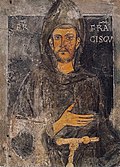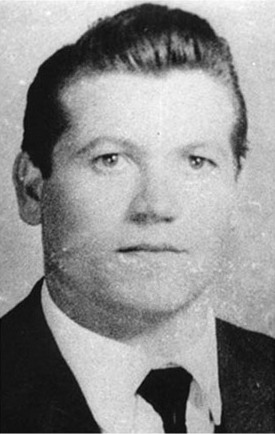
Bernardo Provenzano was an Italian mobster and chief of the Sicilian Mafia clan known as the Corleonesi, a Mafia faction that originated in the town of Corleone, and de facto the boss of bosses. His nickname was Binnu u tratturi because, in the words of one informant, "he mows people down". Another nickname was il ragioniere, due to his apparently subtle and low-key approach to running his crime empire, at least in contrast to some of his more violent predecessors.

Salvatore Achille Ettore Lima was an Italian politician from Sicily who was associated with, and murdered by, the Sicilian Mafia. He is often just referred to as Salvo Lima. According to the pentito Tommaso Buscetta, Lima's father, Vincenzo Lima, was a member of the Mafia but is not known whether Lima himself was a "made member" of Cosa Nostra. In the final report of the first Italian Antimafia Commission (1963–1976), Lima was described as one of the pillars of Mafia power in Palermo.
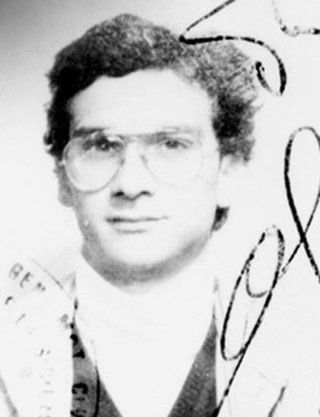
Matteo Messina Denaro, also known as Diabolik, was a Sicilian Mafia boss from Castelvetrano. He was considered to be one of the new leaders of the Sicilian mob after the arrests of Bernardo Provenzano on 11 April 2006 and Salvatore Lo Piccolo in November 2007. The son of a Mafia boss, Denaro became known nationally on 12 April 2001 when the magazine L'Espresso put him on the cover with the headline: Ecco il nuovo capo della Mafia.

Piersanti Mattarella was an Italian politician who was assassinated by the Mafia while he held the position of President of the Regional Government of Sicily. A member of Christian Democracy, he was the brother of Sergio Mattarella, who has been President of Italy since 2015.
Antonino "Nino" Giuffrè is an Italian mafioso from Caccamo in the Province of Palermo, Sicily. He became one of the most important Mafia turncoats after his arrest in April 2002.
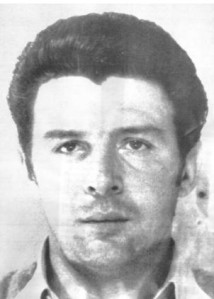
Vincenzo Puccio was a member of the Sicilian Mafia. He was from Palermo and joined the Ciaculli Mafia family sometime in the late 1970s, although like many other members of that particular family he operated a great deal under the orders of the Corleonesi.

Rosario Riccobono was a member of the Sicilian Mafia. He was the boss of Partanna Mondello, a suburb of Palermo, his native city. In 1974 he became a member of the Sicilian Mafia Commission. During the 1970s Riccobono was one of the most influential members of the Commission, and the Cosa Nostra's king of the drug trafficking.

Francesco Marino Mannoia is a former member of the Sicilian Mafia who became a pentito in 1989. His nickname was Mozzarella. He is considered to be one of the most reliable government witnesses against the Mafia. Antimafia magistrate Giovanni Falcone, who was first to interrogate him, recalled Marino Mannoia as an intelligent and reliable witness.
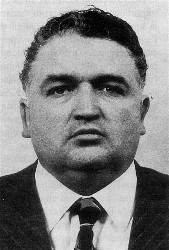
Giuseppe Di Cristina was a powerful mafioso from Riesi in the province of Caltanissetta, Sicily, southern Italy. Di Cristina, nicknamed “la tigre’’, was born into a traditional Mafia family, his father Francesco Di Cristina and his grandfather were men of honour as well.
Gaspare Mutolo is a Sicilian mafioso, also known as "Asparino". In 1992 he became a pentito. He was the first mafioso who spoke about the connections between Cosa Nostra and Italian politicians. Mutolo’s declarations contributed to the indictment of Italy’s former Prime Minister Giulio Andreotti and to an understanding of the context of the 1992 Mafia murders of the politician Salvo Lima and the magistrates Giovanni Falcone and Paolo Borsellino.

Giuseppe Graviano is an Italian mafioso from the Brancaccio quarter in Palermo. He also was one the men of the death squad that murdered Salvatore Contorno's relatives. He is currently serving several life sentences. He and his three siblings became members of the Sicilian Mafia Commission for the Brancaccio-Ciaculli mandamento, substituting Giuseppe Lucchese who was in prison.
Santino Di Matteo, also known as Mezzanasca, is an Italian former member of the Sicilian Mafia from the town of Altofonte in the province of Palermo, Sicily, Italy.
Operation Old Bridge is the code name for the February 7, 2008 arrests in Italy and the United States that targeted the Gambino crime family; among the indicted were the reputed acting bosses Jackie D'Amico, Nicholas Corozzo and Joseph Corozzo. The indictments included murder, drug trafficking, robbery, and extortion.

Gaspare Spatuzza is a Sicilian mafioso from the Brancaccio quarter in Palermo. He was an assassin for the brothers Filippo and Giuseppe Graviano who headed the Mafia family of Brancaccio. After the arrest of the Gravianos in January 1994, he apparently succeeded them as the regent of the Mafia family. He was arrested in 1997 and started to cooperate with the judicial authorities in 2008. In his testimony, he stated that media tycoon and then prime minister Silvio Berlusconi made a deal with the Sicilian Mafia in 1993 that put the country in the hands of Cosa Nostra.

Salvatore Riina, called Totò, was an Italian mobster and chief of the Sicilian Mafia, known for a ruthless murder campaign that reached a peak in the early 1990s with the assassinations of Antimafia Commission prosecutors Giovanni Falcone and Paolo Borsellino, resulting in widespread public outcry and a major crackdown by the authorities. He was also known by the nicknames la belva and il capo dei capi.

Giuseppe Greco was a hitman and high-ranking member of the Sicilian Mafia. A number of sources refer to him exclusively as Pino Greco, although Giuseppe was his Christian name; Pino is a frequent abbreviation of the name Giuseppe.
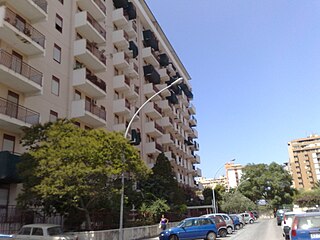
The via D'Amelio bombing was a terrorist attack by the Sicilian Mafia, which took place in Palermo, Sicily, Italy, on 19 July 1992. It killed Paolo Borsellino, the anti-mafia Italian magistrate, and five members of his police escort: Agostino Catalano, Emanuela Loi, Vincenzo Li Muli, Walter Eddie Cosina, and Claudio Traina.

The Oratory of Saint Lawrence is a Baroque oratory of Palermo. It is located near the Basilica of Saint Francis of Assisi, in the quarter of the Kalsa, within the historic centre of Palermo.
The term State-Mafia Pact describes an alleged series of negotiations between important Italian government officials and Cosa Nostra members that began after the period of the 1992 and 1993 terror attacks by the Sicilian Mafia with the aim to reach a deal to stop the attacks; according to other sources and hypotheses, it began even earlier. In summary, the supposed cornerstone of the deal was an end to "the Massacre Season" in return for a reduction in the detention measures provided for Italy's Article 41-bis prison regime. 41-bis was the law by which the Antimafia pool led by Giovanni Falcone had condemned hundreds of mafia members to the "hard prison regime". The negotiation hypothesis has been the subject of long investigations, both by the courts and in the media. In 2021, the Court of Appeal of Palermo acquitted a close associate of former prime minister Silvio Berlusconi, while upholding the sentences of the mafia bosses. This ruling was confirmed by the Italian Supreme Court of Cassation in 2023.
Giovanni Ravalli was an Italian military officer who was imprisoned for war crimes he committed during the Axis occupation of Greece during World War II. Following a pardon, he served as police prefect of Palermo, investigating the theft of Caravaggio's Nativity with St. Francis and St. Lawrence.
















